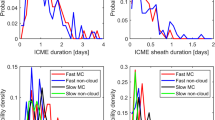Abstract
The energetic charged particle, interplanetary magnetic field, and plasma characteristics of the `Bastille Day' shock and ejecta/magnetic cloud events at 1 AU occurring over the days 14–16 July 2000 are described. Profiles of MeV (WIND/LEMT) energetic ions help to organize the overall sequence of events from the solar source to 1 AU. Stressed are analyses of an outstanding magnetic cloud (MC2) starting late on 15 July and its upstream shock about 4 hours earlier in WIND magnetic field and plasma data. Also analyzed is a less certain, but likely, magnetic cloud (MC1) occurring early on 15 July; this was separated from MC2 by its upstream shock and many heliospheric current sheet (HCS) crossings. Other HCS crossings occurred throughout the 3-day period. Overall this dramatic series of interplanetary events caused a large multi-phase magnetic storm with min Dst lower than −300 nT. The very fast solar wind speed (≥ 1100 km s−1) in and around the front of MC2 (for near average densities) was responsible for a very high solar wind ram pressure driving in the front of the magnetosphere to geocentric distances estimated to be as low as ≈ 5 R E, much lower than the geosynchronous orbit radius. This was consistent with magnetic field observations from two GOES satellites which indicated they were in the magnetosheath for extended times. A static force-free field model is used to fit the two magnetic cloud profiles providing estimates of the clouds' physical and geometrical properties. MC2 was much larger than MC1, but their axes were nearly antiparallel, and their magnetic fields had the same left-handed helicity. MC2's axis and its upstream shock normal were very close to being perpendicular to each other, as might be expected if the cloud were driving the shock at the time of observation. The estimated axial magnetic flux carried by MC2 was 52×1020 Mx, which is about 5 times the typical magnetic flux estimated for other magnetic clouds in the WIND data over its first 4 years and is 17 times the flux of MC1. This large flux is due to both the strong axially-directed field of MC2 (46.8 nT on the axis) and the large radius (R 0=0.189 AU) of the flux tube. MC2's average speed is consistent with the expected transit time from a halo-CME to which it is apparently related.
Similar content being viewed by others
References
Acuña, M. H., Burlaga, L. F, Lepping, R. P., and Ness, N. F: 1981, in H. Rosenbauer (ed.), Solar Wind Four, Rep. MPAE-100-81-31, Max Plank Institute, Lindau, Germany, p. 143.
Akasofu, S.-I.: 1981, Space Sci. Rev. 28, 121.
Bargatze, L. F., McPherron, R. L., and Baker, D. N.: 1986, in Y. Kamide and J. A. Slavin (eds.), Solar Wind-Magnetosphere Coupling, Terra Scientific Publ. Co., Tokyo, pp. 101-109.
Berdichevsky, D. B. et al.: 2000, J. Geophys. Res. 105, 27289.
Berdichevsky, D. B. et al.: 2001, Ann. Geophys., submitted.
Bothmer, V. and Schwenn, R. H.: 1998, Ann. Geophys. 16, 1.
Brueckner, G. E. et al.: 1995, Solar Phys. 162, 357.
Burlaga, L. F.: 1988, J. Geophys. Res. 93, 7217.
Burlaga, L. F.: 1995, Interplanetary Magnetohydrodynamics, Oxford University Press, New York.
Burlaga, L. F., Sittler, E., Mariani, F., and Schwenn, R.: 1981, J. Geophys. Res. 86, 6673.
Choe, J. T., Beard, D. B., and Sullivan, E. C.: 1973, Planetary Space Sci. 21, 485.
Collier, M. R. et al.: 2001, J. Geophys. Res. 106, 15985.
Crooker, N. U. and Intriligator, D. S.: 1997, J. Geophys. Res. 102, 24343.
Crooker, N. U., Gosling, J. T., and Kahler, S. W.: 1998, J. Geophys. Res. 103, 301.
Delaboudinière, J.-P. et al.: 1995, Solar Phys. 162, 291.
Farrugia, C. J. et al.: 1992, in R. Schwenn (ed.), Solar Wind Seven, Pergamon, New York, p. 61.
Goldstein, H.: 1983, M. Neugebauer (ed.), Solar Wind Five, NASA Conf. Publ., 2280, p. 731.
Gopalswamy, N. et al.: 1998, Geophys Res. Lett. 25, 2485.
Gosling, J. T.: 1990: in C. T. Russell, E. R. Priest, and L. C. Lee (eds.), Physics of Magnetic Flux Ropes, Geophys. Monogr. Ser. 58, AGU, Washington, DC, p. 343.
Klein, L. W. and Burlaga, L. F.: 1982, J. Geophys. Res. 87, 613.
Lepping, R. P. and Berdichevsky, D. B.: 2000, Recent Research Developments in Geophysical Research, Issue 3, Research Signpost, Trivandrum-8, India, p. 77.
Lepping, R. P., Jones, J. A., and Burlaga, L. F.: 1990, J. Geophys. Res. 95, 11957.
Lepping, R. P. et al.: 1995, Space Sci. Rev. 71, 207.
Lepping, R. P., Berdichevsky, D. B., Szabo, A., Lazarus, A. J., and Thompson, B. J.: 2001, Adv. Space Res. 26, in press.
Lundquist, S.: 1950, Arkiv Fys. 2, 361.
Marubashi, K.: 1986, Adv. Space Res. 6, 335.
Mulligan, T., Russell, C. T., Anderson, B. J., and Acuña, M. H.: 2001, Geophys. Res. Lett., submitted.
Ogilvie, K. W. et al.: 1995, Space Sci. Rev. 71, 55.
Osherovich, V. I. and Burlaga, L. F.: 1997, in N. Crooker et al. (eds.), Coronal Mass Ejections, GM99, Washington, D. C., AGU, p. 157.
Osherovich, V. I., Farrugia, C. J., and Burlaga, L. F.: 1993, Adv. Space Res. 13, 57.
Reames, D. V., Ng, C. K., and Tylka, A. J.: 2001, Astrophys. J. 548, L233.
Reiner, M. et al.: 2001, Solar Phys., this issue.
Shue, J.-H. et al.: 1997, J. Geophys. Res. 102, 9497.
Smith, E. J. and Burton, M. E.: 1988, J. Geophys. Res. 93, 2730.
Smith, C.W.et al.: 2001, Solar Phys., this issue.
St.Cyr, O.C.et al.: 2000, J. Geophys. Res. 105, 18169.
von Rosenvinge, T. T. et al.: 1995, Space Sci. Rev. 71, 155.
Webb, D. F. et al.: 2000, J. Geophys. Res. 105, 7491.
Author information
Authors and Affiliations
Rights and permissions
About this article
Cite this article
Lepping, R., Berdichevsky, D., Burlaga, L. et al. The Bastille day Magnetic Clouds and Upstream Shocks: Near-Earth Interplanetary Observations. Sol Phys 204, 285–303 (2001). https://doi.org/10.1023/A:1014264327855
Issue Date:
DOI: https://doi.org/10.1023/A:1014264327855




